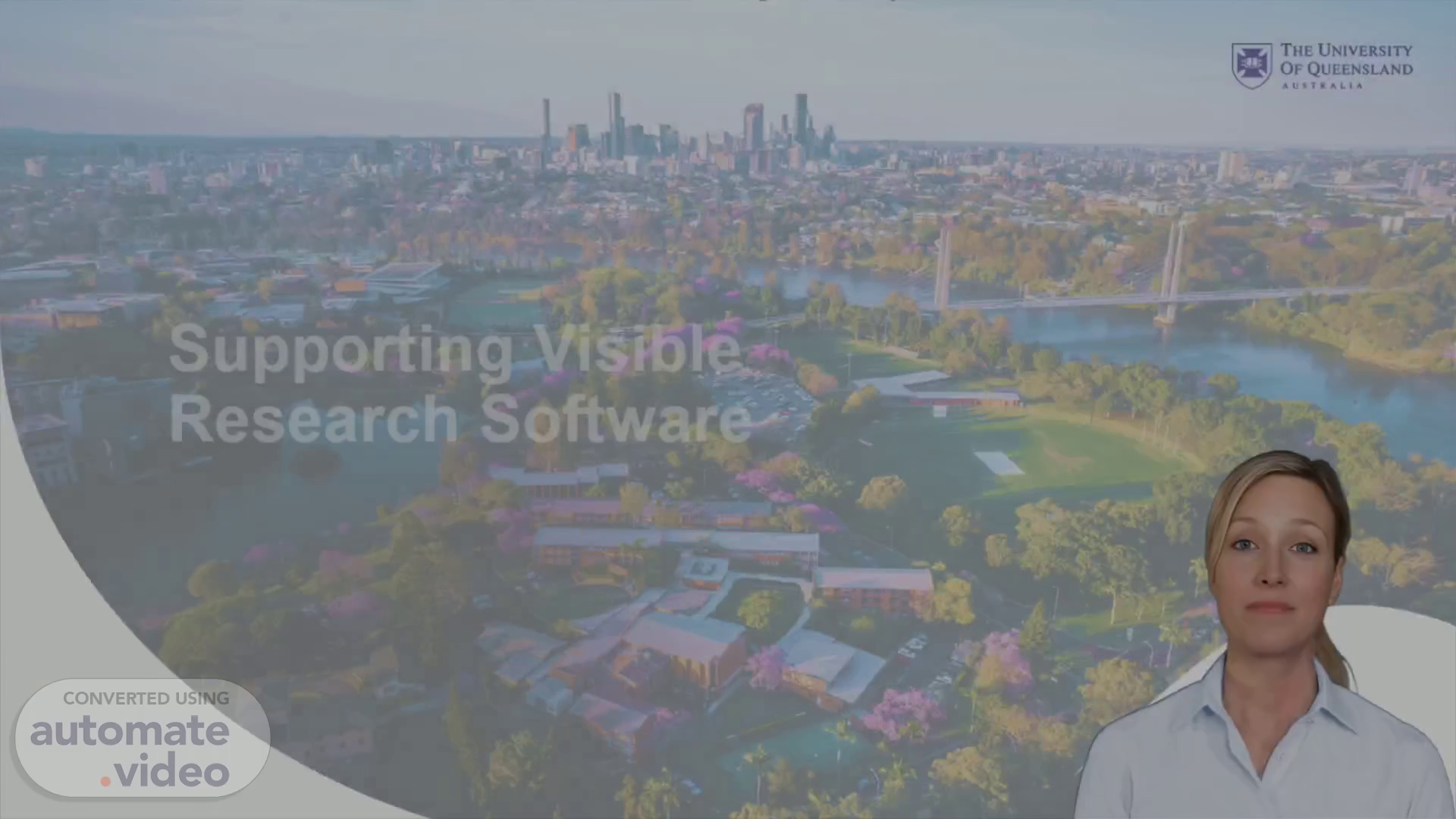
Supporting Visible Research Software
Scene 1 (0s)
[Virtual Presenter] Good afternoon everyone, today I am here to discuss the new resource recently launched by the University of Queensland Library. This resource is intended to help researchers use open research software to produce research outputs that comply with journal and funder policies. We will explore how this resource can help make research software more visible and FAIR for the academic community. Let us begin by learning more about Susan Wilson and the resource she created..
Scene 2 (31s)
[Audio] We have come to slide number two of our presentation which looks at the recent launch of a new resource by Susan Wilson, Research Data Management Specialist at UQ. This resource provides researchers with an understanding of the importance of open research software and the various ways in which they can make their software visible as a research output. UQ's project began with research support and conversations with researchers, ARDC, and other entities in the field. Through this process, journals and funders began to develop policies to support software sharing and reproducibility. These policies advocate the development of FAIR research software, based on the FAIR principles of Findability, Accessibility, Interoperability, and Reusability. This is a significant step forward in the research-software-sharing process and its potential impact is exciting..
Scene 3 (1m 29s)
[Audio] The FAIR principles for research software provide a resource to support visible software outputs. The acronym stands for Findable, Accessible, Interoperable, and Reusable, and this resource offers an overview of the principles as well as guidance on journal and funder policies. It is designed to help researchers navigate open research software and make their own software visible as an output. Such a resource is important to ensure that research outputs are properly recognized and are able to build upon the work of others. Let's take a closer look at the details..
Scene 4 (2m 8s)
[Audio] UNESCO Recommendations on Open Science are noteworthy for stressing the relevance of research software as a key research output. The FAIR principles are fundamental for establishing software visibility and availability. In line with these goals, Susan Wilson has made available a new resource that enables researchers to quickly locate and use open research software, as well as make their own software visible as a research output. This is an indispensable step towards guaranteeing adequate acknowledgment of research software as a useful research output..
Scene 5 (2m 45s)
[Audio] Susan Wilson has recently launched a new resource developed by the Australian Research Data Commons. Its purpose is to assist researchers in showcasing their software as a research output and also to help them find open research software. This is in accordance with the UNESCO recommendation on Open Science, which encourages researchers to make their data and software accessible to the public. This resource will provide them with the necessary tools to do so..
Scene 6 (3m 16s)
[Audio] Susan Wilson, Research Data Management Specialist at UQ, has created a new resource that supports researchers in navigating open research software and making their own software visible as a research output. Open data implies the need for open software, and this guide seeks to provide guidance and support in this area, particularly for those who are not professional software engineers but are creating code as part of their work, or those who want to use open tools to support reproducibility. Its ultimate goal is to support a culture of open science practices..
Scene 7 (3m 53s)
[Audio] Software plays a key role throughout the research process, from concept generation to data generation, analysis, composing publications, and more. Nevertheless, not all researchers have knowledge of software engineering. The University of Queensland's new resource is therefore significant, as it gives researchers a guide to make full use of open research software, and to make their work noticeable as a research output. This guide grants researchers with best practices in using open software and generating software that can be shared, quoted, and acknowledged. This also allows non-traditional users and makers to be involved in open software support, and ensures that researchers comprehend the advantages of open science, including improved performance, transparency, reproducibility, and invention. By taking advantage of the new resource, researchers can make good use of open software support, and make certain that their work is appreciated..
Scene 8 (4m 57s)
[Audio] Susan Wilson has launched a highly beneficial guide on open source tools for research, as well as how to share and publish code or software created as part of the research. This guide contains a wide array of research tools that can be used in various stages of the research lifecycle, and also provides advice on observing FAIR principles when citing any software used. It will be a great aid for researchers wanting to take advantage of open source software tools in their work..
Scene 9 (5m 27s)
[Audio] Software is an integral part of research projects, and when code is open and shared it can significantly expand its reach. This guide elaborates on the mechanisms that facilitate sharing code, such as employing version control and applying licenses and software citations. In addition, the guide covers UQ systems that can help researchers share code without making too many modifications to their processes. Overall, this guide should provide researchers with the information they need to effectively make their software accessible to other parties, thus increasing the visibility of their research and paving the way for more collaboration..
Scene 10 (6m 9s)
[Audio] Susan Wilson, your introduction of this new resource to assist researchers in their open research software projects is greatly appreciated. By doing so, it is making research work more attainable and emphasising its significance. With this resource, one can expect an increase in the volume of high quality research outputs from UQ. Much gratitude is expressed..